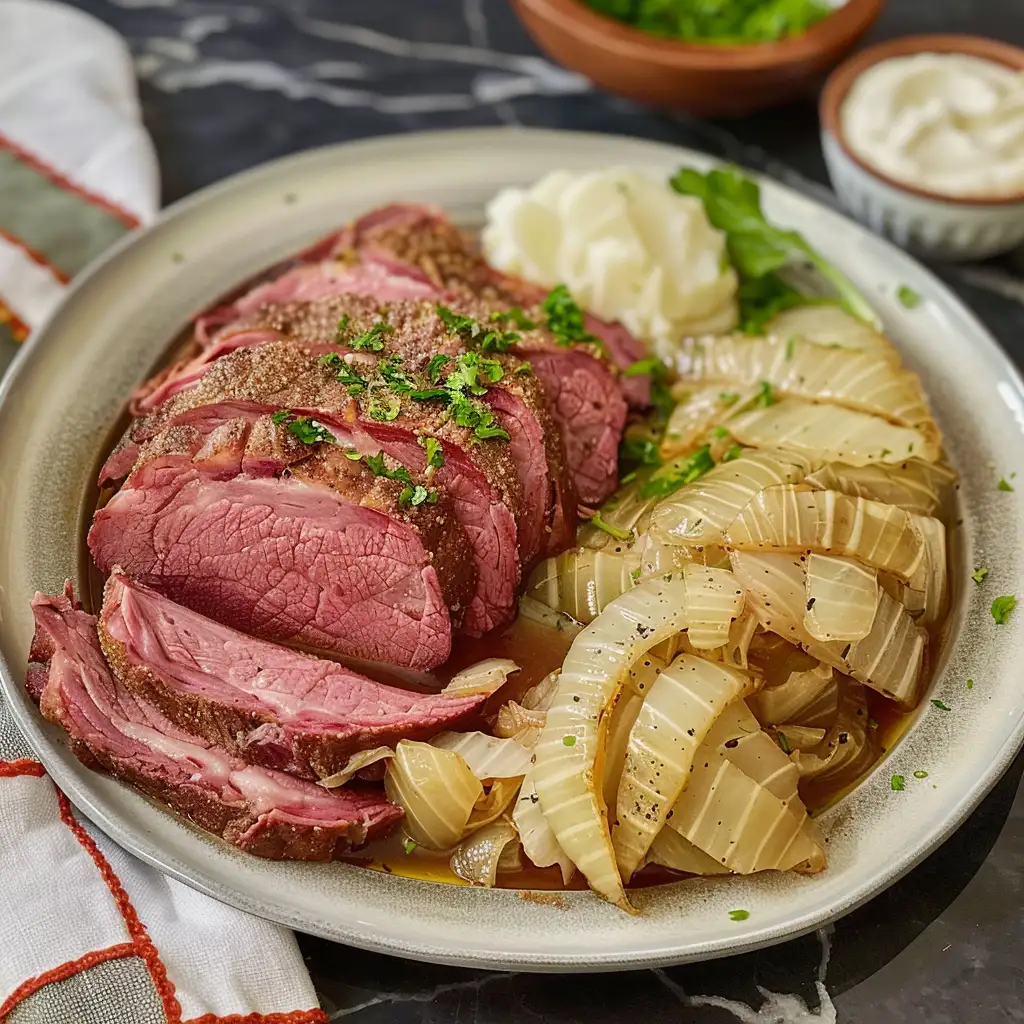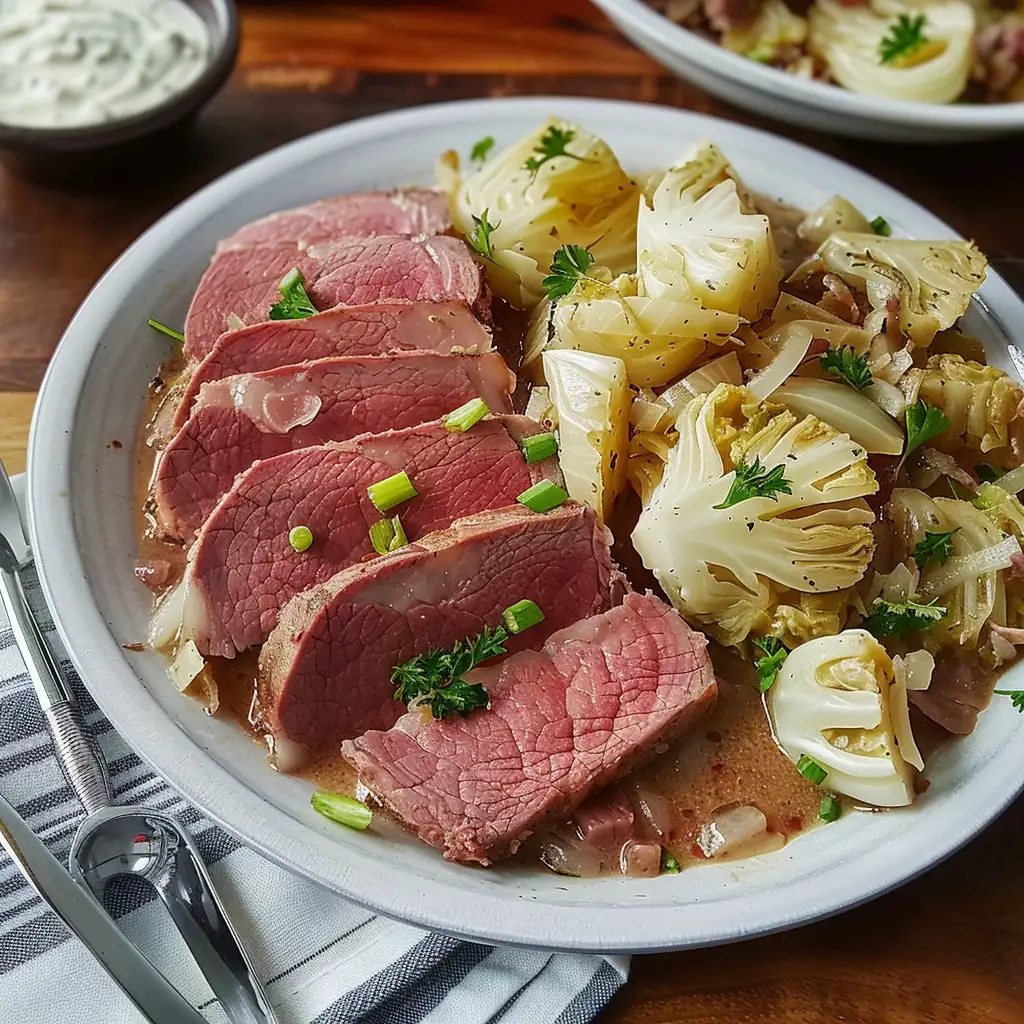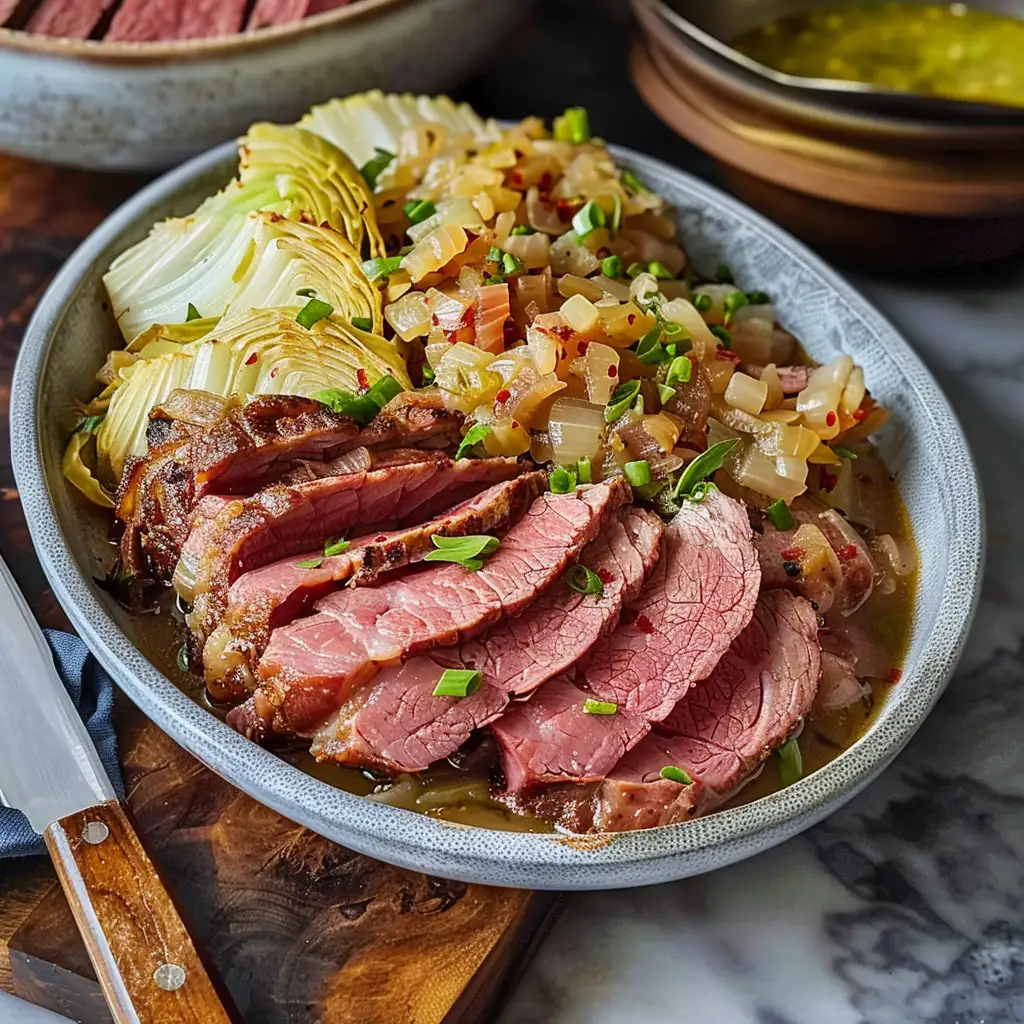Introduction to Corned Beef and Cabbage
Corned Beef and Cabbage, a dish steeped in historical significance, has become synonymous with St. Patrick’s Day, especially among the Irish-American communities. The tradition of enjoying this savory meal on the 17th of March traces back to the early 19th century when Irish immigrants in America found corned beef to be a suitable substitute for their beloved bacon. This substitution was made out of necessity, as corned beef was a more affordable option. The pairing with cabbage came naturally, as it was a common vegetable available to the working class. An engaging anecdote that resonates with many involves the accidental purchase of a corned beef brisket instead of the usual beef brisket, leading to unexpected culinary experiments and, eventually, the discovery of a deliciously tender meat that requires no marination in savory ingredients.
What Makes Corned Beef and Cabbage Special?
The cultural importance of Corned Beef and Cabbage within Irish-American communities cannot be overstated. It embodies the resilience and adaptability of the Irish people, transforming economical necessities into cherished traditions. This dish’s versatility in preparation adds to its special status. Whether boiled, braised, or roasted, each method offers a unique flavor profile and texture, catering to different palates. Explore the St. Patrick’s Day traditions to understand the depth of its cultural significance further.
The Essential Ingredients
Selecting the Corned Beef
When it comes to preparing Corned Beef and Cabbage, the choice of meat is paramount. Here’s what to look for:
- Types of corned beef cuts: The brisket, the most common cut used for corned beef, is divided into two parts—the flat cut and the point cut. The flat cut is leaner and more consistent in shape, making it ideal for slicing, while the point cut is fattier, offering richer flavors.
- The role of the spice packet and alternatives: Most packaged corned beef comes with a spice packet that adds traditional flavors. However, for those looking to customize their dish, discarding the packet and using fresh spices like peppercorns, bay leaves, and mustard seeds can elevate the dish to new heights. For further inspiration on using spices in cooking, the Allrecipes Corned Beef and Cabbage Recipe provides excellent guidance.
Selecting the right ingredients and cooking method for Corned Beef and Cabbage can transform a simple meal into a festive celebration, imbuing it with the history and heart of Irish-American culture.
Preparing the Cabbage
When making Corned Beef and Cabbage, selecting and preparing the cabbage is just as crucial as the meat. Here’s how to do it right:
- Choosing the right type of cabbage: Green cabbage is traditional for its mildly sweet flavor and crisp texture. Look for heads that feel heavy for their size with tightly packed leaves.
- Cutting techniques for different textures: For a softer texture, shred the cabbage; for a more rustic and hearty feel, cut it into wedges. Keeping a bit of the core on each wedge helps it hold together during cooking.

Cooking Process
Cooking the Corned Beef
A step-by-step guide to perfectly cooked Corned Beef:
- Preparation: Begin by rinsing the corned beef under cold water to remove excess salt. Pat it dry.
- Seasoning: If your corned beef comes with a spice packet, sprinkle it over the top. For a personal touch, add extra black pepper, garlic, and bay leaves.
- Oven Roasting: Place the corned beef, fat side up, in a deep baking dish. Cover tightly with aluminum foil and roast in a preheated oven at 325°F. After about 3 hours, check for tenderness.
- Finishing Touches: Once the meat is fork-tender, uncover and increase the oven temperature to brown the top slightly.
Tips for achieving fork-tender meat:
- Low and slow is the key. The low cooking temperature over several hours breaks down the tough fibers.
- Keep it moist by baking it covered for the majority of the cooking time.
Making the Cabbage
For cabbage that complements the corned beef:
- Searing: Begin by heating some olive oil in a heavy skillet. Sear the cabbage wedges on both sides until they are nicely browned, adding flavor and texture.
- Baking with Beer: Arrange the seared cabbage in a baking dish and pour half a bottle of Guinness or another dark beer around them. The beer not only adds moisture for steaming but infuses the cabbage with a unique, malty flavor.
- Oven Finishing: Bake at 350°F until the cabbage is tender and has absorbed some of the beer’s essence, about 20 minutes.
For a detailed take on using beer to enhance your dishes, see A modern twist on Corned Beef and Cabbage for additional insights and inspiration.
This approach to cooking both the corned beef and cabbage ensures a meal rich in flavor and tradition, perfect for any St. Patrick’s Day celebration or a comforting family dinner.
Balsamic Reduction and Final Touches
A balsamic reduction can add a sweet and tangy complement to the savory flavors of corned beef and cabbage. Here’s how to make it:
- Preparation: Simmer one cup of balsamic vinegar on medium heat until it reduces by half and thickens to a syrup-like consistency. For a touch of sweetness, you can stir in up to two tablespoons of sugar.
- Usage: Drizzle the reduction over the cabbage wedges just before serving, adding a depth of flavor and a touch of elegance to the dish.
Arranging the dish for serving involves placing the fork-tender corned beef slices or shreds on a large platter, surrounded by the balsamic-glazed cabbage wedges. The contrasting flavors and textures make each bite a delight.

Complementary Dishes and Leftover Ideas
Complementary Sides
Enhance your Corned Beef and Cabbage meal with sides that complement its rich flavors:
- Suggested sides: Boiled potatoes and grainy mustard are traditional accompaniments that balance the meal. The potatoes absorb the meat’s juices, while the mustard adds a spicy kick.
- Importance of side dishes: They not only add variety and completeness to the meal but also cater to different taste preferences, ensuring a well-rounded dining experience.
Innovative Leftover Ideas
Transform your leftovers into new and exciting dishes:
- Corned beef sandwiches: Layer slices of corned beef, a smear of mustard, and cabbage between slices of rye bread for a classic deli-style sandwich.
- Corned beef hash: Fry up diced potatoes, corned beef, and onions for a hearty breakfast.
- Cabbage casseroles: Combine leftover cabbage with rice, cheese, and cream of mushroom soup for a comforting bake.
- Creative repurposing: Turn leftover cabbage into coleslaw or add it to soups and stews for extra nutrition and flavor.
For more creative ideas on repurposing leftovers, The Suburban Soapbox offers unique takes on traditional dishes, ensuring your Corned Beef and Cabbage meal extends beyond a single dining experience. These ideas not only maximize the value of your ingredients but also keep your meals interesting and flavorful.

FAQs Section
When diving into the world of Corned Beef and Cabbage, several questions frequently arise. Here are answers to some of the most common queries:
- How do you know when corned beef is done?
- Corned beef is considered done when it is fork-tender. This means that a fork can easily slide into the meat without resistance. A good internal temperature to aim for is around 145°F (63°C), but the key indicator is the ease with which a fork goes through the meat.
- What can you do with leftover corned beef?
- Leftover corned beef offers a multitude of possibilities:
- Corned beef sandwiches: A classic choice, simply layer slices on rye bread with your choice of condiments.
- Corned beef hash: Chop the beef into small pieces and fry with potatoes and onions for a savory breakfast.
- Salads and casseroles: Add chopped corned beef to salads for protein or incorporate it into casseroles for a hearty meal.
- For more inspiration on utilizing leftovers creatively, check out Allrecipes Corned Beef and Cabbage Recipe, which provides several innovative ideas.
- Leftover corned beef offers a multitude of possibilities:
- Can the dish be made in advance?
- Yes, Corned Beef and Cabbage can be made in advance, which is actually beneficial:
- Cooking the corned beef a day ahead allows the flavors to meld and deepen.
- The cabbage can be prepped and stored separately. Reheat the meat gently, adding the cabbage during the last few minutes to maintain its texture and color.
- Making the dish ahead of time can ease the preparation process, especially for large gatherings.
- Yes, Corned Beef and Cabbage can be made in advance, which is actually beneficial:
These FAQs aim to clear up any confusion and ensure that your Corned Beef and Cabbage experience is as smooth and enjoyable as possible. Remember, the key to a perfect dish lies in the tenderness of the meat and the freshness of the cabbage, so don’t hesitate to take your time and enjoy the cooking process.

